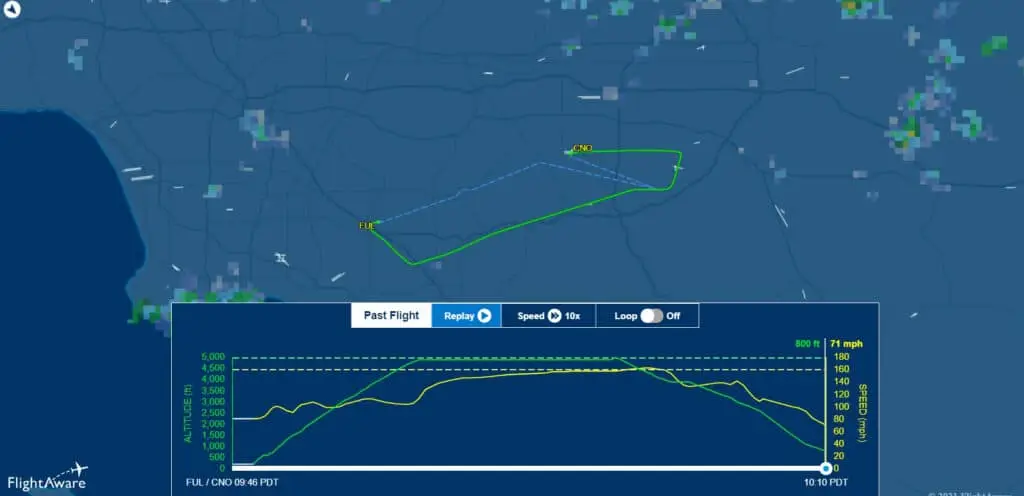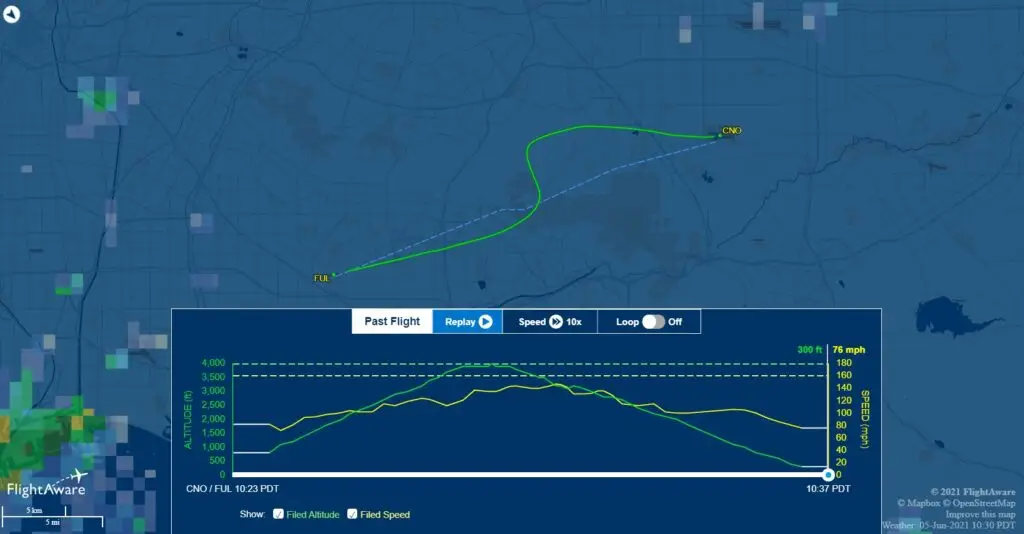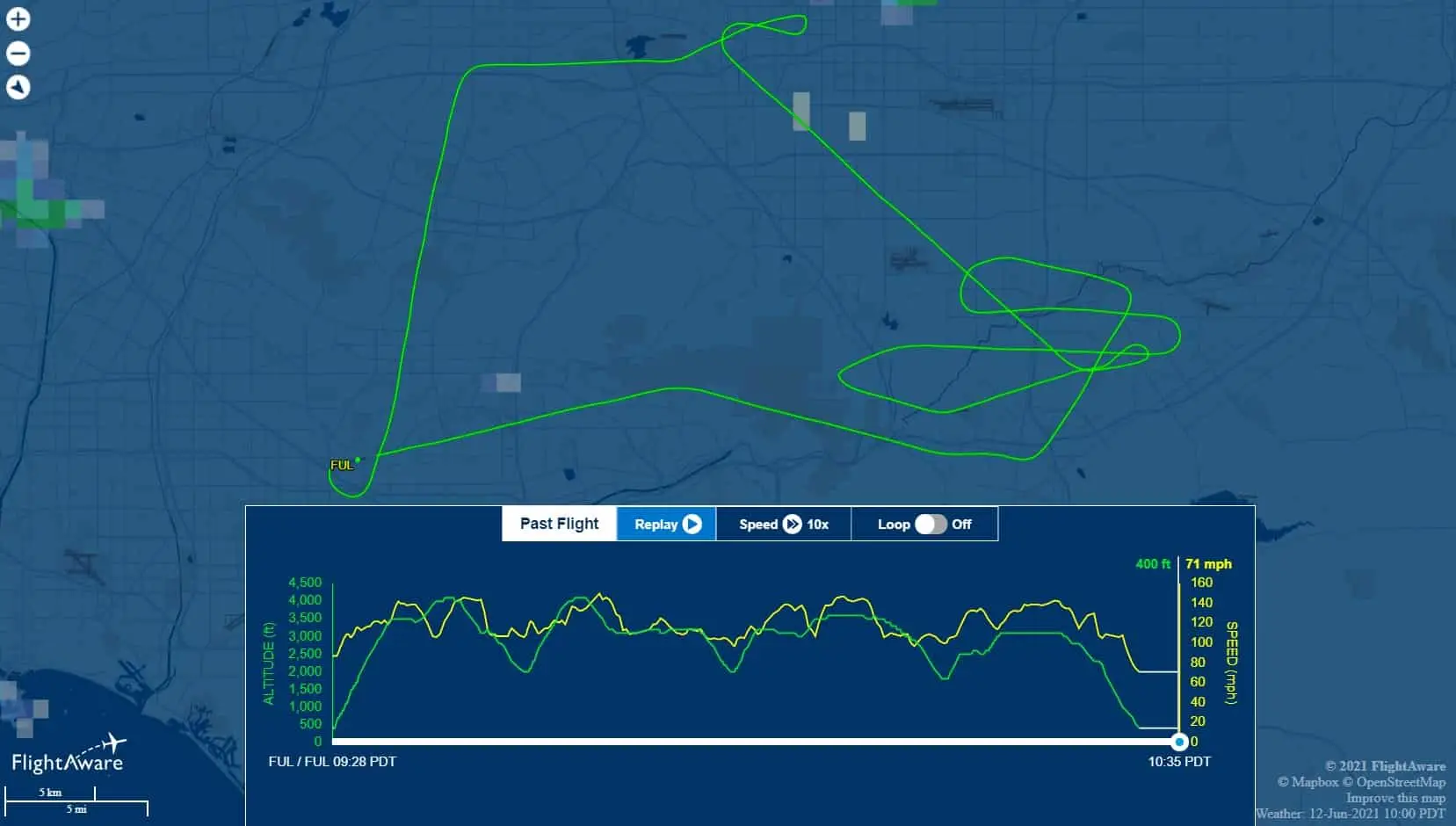After a month without any IFR training I finally got back in the air. The plane was down three and a half weeks for the GFC500 Autopilot installation and then there was a weekend trip to St. George for a family reunion. I used the autopilot for the flight there and back and it was AMAZING! Landing in St. George I was as fresh mentally and physically as if I had just taken off fifteen minutes earlier, not a little over two hours earlier. However, that is a post for a different day, this one is about my ongoing IFR Training.
Fights 15-17 took place on June 5th, 9th and 12th.
Flight 15 – June 5th

Once again the hopes of getting some actual IMC evaporated as things warmed up. Despite the traditional “June Gloom” with a marine layer that hangs on until mid-day, there were only a few patchy clouds at 9am. Looking for a change from the round robin flight with approaches at multiple airports we filed TEC routes from Fullerton (KFUL) to Chino (KCNO) and back.
I discussed use of the autopilot with my CFII and we decided that I would use it for the en-route portion of this flight and then disconnect to hand fly the approach. The difference in the mental workload with the autopilot as opposed to without it is night and day. I am glad that I have it but will continue to use it sparingly in training to build those skills hand flying on instruments.
When ATC gave us a heading to intercept final and clearance to fly the approach I pressed the disconnect button and did my best to fly down the glideslope. After over a month without any IFR time I could tell I was trying to stay in front of the plane, with “trying” as the operative word. It wasn’t terrible, but I did feel like I was behind and trying to catch up on most of the approach.
We landed and taxied back, pulling up next to a P-51 in the run-up area where we picked up our IFR clearance back to KFUL.

I hand flew the return flight and approach and felt like I was getting back in the groove.
Flight 16 – June 9th

Filing and flying an IFR plan is a much lower workload than the round robin multiple approaches to different airports, but pushing your mental limits in training is the way to improve so it was back to flying approaches.
We started with the GPS-A to Corona (KAJO) because that would require a procedure turn to fly the approach. After going missed we were back talking to SoCal Approach who vectored us around to fly the RNAV RWY 26R approach into Chino (KCNO). After the low approach at KCNO it was back to fly the RNAV RWY24 into KFUL for a full stop landing.
The approaches improved as the flight progressed and the approach into KFUL was spot on. Despite having a state of the art autopilot in the panel it was never turned on and I hand flew everything. The autopilot would have been great to use, but the training is to stretch and expand abilities and skills which comes from hand flying, not just pushing buttons on the panel.
Flight 17 – June 12th

That’s a lot of spaghetti on the Flight Aware track. If three approaches to three different airports on one flight is good then four is better, right? We started with the RNAV RWY 06 at Cable (KCCB) which is a new approach I hadn’t flown yet. We followed that with the GPS-A at Corona (KAJO) which required a procedure turn. I think everyone was out flying approaches, it was busy on the radios. After going missed at KAJO I called up SoCal again to request the RNAV RWY 09 at Riverside (KRAL). They were landing on 27 but 09 is the practice approach everyone flies because it keeps you away from March ARB’s airspace.
SoCal: “Mooney 78878, you will be number 5 for the approach, did you want to do something different?”
I asked my CFII and he said “We have the time, let’s fly it.”
I got back on the radio and told SoCal we we would continue with the approach and he started vectoring us around to get us in sequence for the approach. On the third heading change we also got this instruction.
SoCal: “Mooney 78878, slow to 90 knots, you are following a Cessna.”
Me: “Slow to 90 knots, 878.”
To my CFII is said, “That’s slow, only about 100 miles per hour.” ATC talks in knots but everything in my plane is in MPH so that’s what I reference on my airspeed indicator. I slowed us down and even though we weren’t on the approach yet threw the gear out just for a little more stability. ATC cleared us for the practice approach and handed us off to Riverside Tower.
Me: “Riverside tower, Mooney 78878 on the RNAV RWY 09 approach.”
Tower: “Mooney 78878, did you clear this with Approach?”
Me: “Affirmative.”
Tower: “Mooney 78878, Cleared to land runway 09, full stop.”
He was clearly not thrilled to have us inbound against the traffic flow.
Me: “We didn’t want a full stop, just a low approach.”
Tower: “Continue the approach.”
Me: “Continuing, 878.”
We were only 1/2 mile inside the Final Approach Fix (FAF), three miles from the runway and not near the Decision Altitude (DA) where we would go missed when the Tower decided he didn’t have room to accommodate our practice approach.
Tower: “Mooney 78878, begin a right turn, squawk VFR, frequency change approved.”
Me: “Right turn, squawk VFR, frequency change.”
I pressed the VFR button on my transponder which automatically sets it to squawk 1200, pushed the throttle in, pulled up the gear, and began a climbing right turn away from the airport. Instead of calling up SoCal again for flight following my CFII played the role of ATC giving me vectors and altitude assignments to put us on the RNAV approach back into KFUL.
It was a great training flight that stretched me mentally. Unlike the flight on the 5th and portions of the flight on the 9th I felt like I was ahead of the plane on this entire flight. My CFII said I did well and I didn’t miss any radio calls either. I could still feel myself right on the edge of task saturation at times. Normally, when making radio calls they just roll off the tongue like having a conversation. As I approach task saturation it requires more and more effort to get the words to come out the way I want. While I didn’t miss any radio calls, there were times on the flight where I knew what I wanted to say but it took effort to get the words to come out, like my mind was forming the words and my mouth was slow to the party.


